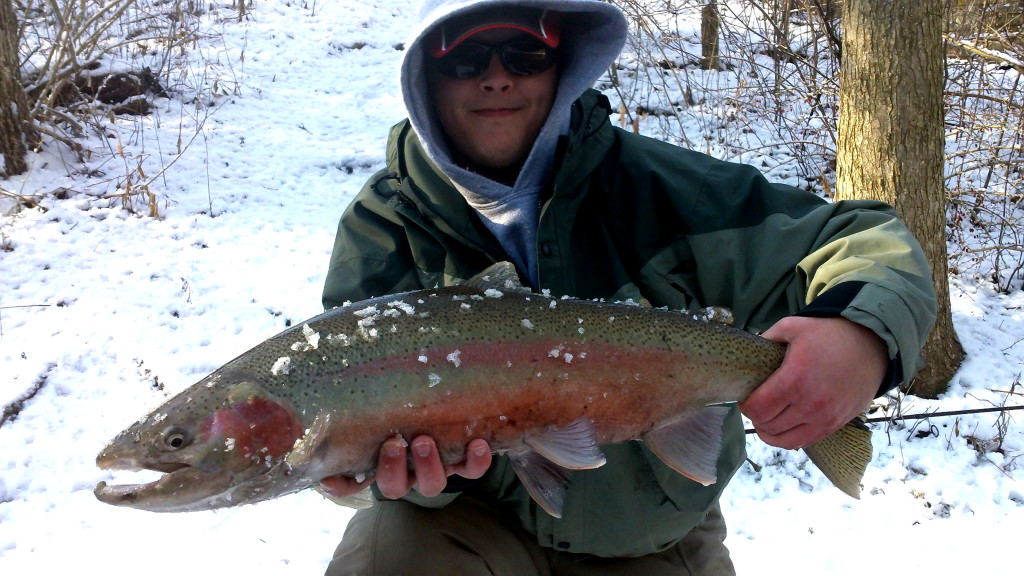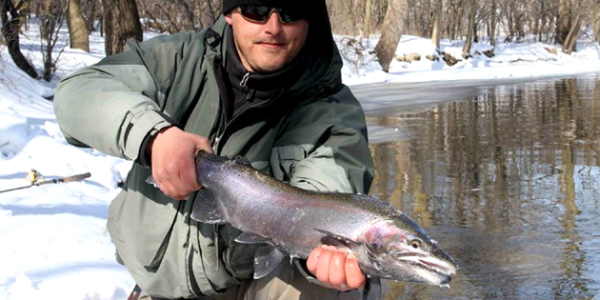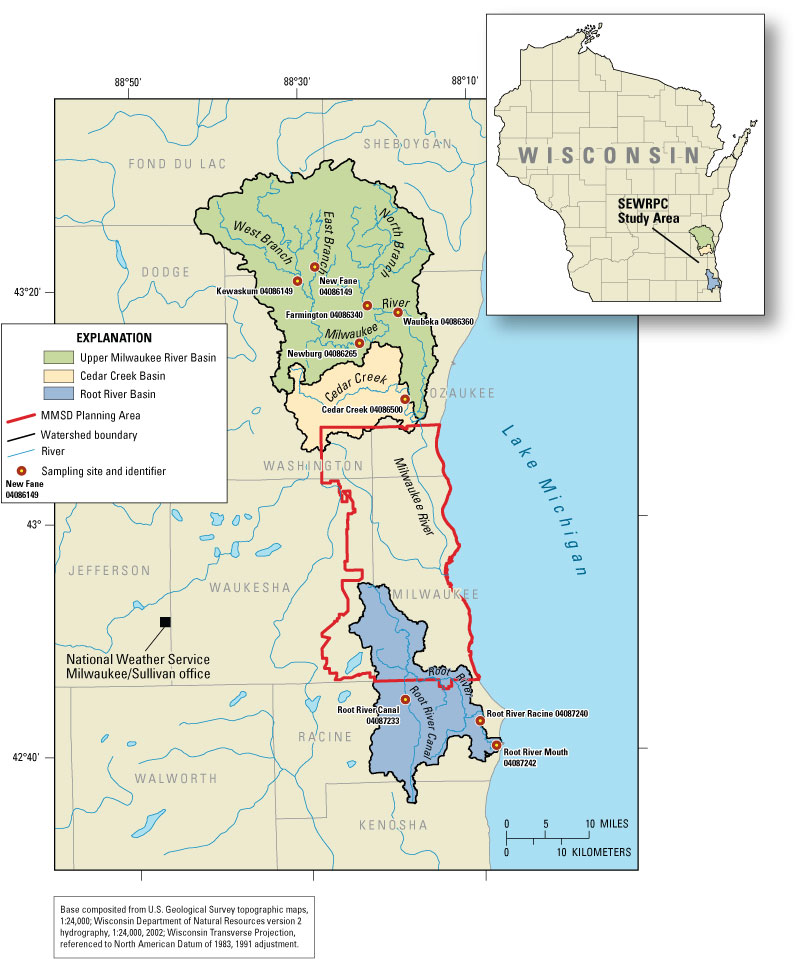By Tim Hyvonen
When you think of ice fishing, most anglers turn to bluegills and crappies but there are a select few who explore the ideas of chrome. While most ice fishermen are in pursuit of other species, there are a few of us strapping on waders and tugging through snow along the Lake Michigan Tributaries in search of late winter and early spring steelhead. It’s not only a much welcome break from ice fishing but it can also be some of the most productive steelhead fishing before the fish begin spawning.
Some of the best steelhead fishing I know of is found along the shores of Lake Michigan from Kewaunee to Kenosha, Wisconsin on the west side and from Manistee, Michigan to Michigan City Indiana on the East side. As a resident of Oak Creek, Wisconsin, there are three primary rivers I fish: The Milwaukee River, Oak Creek, and the Root River.
One of the most notable steelhead rivers in Wisconsin is the Root River in Racine Wisconsin. It has been ranked as one of the best steelhead rivers in the entire United States. Not only does the Root provide some excellent fishing opportunities but there is something on the river that catches the eyes of fishermen of all ages. Due to the lack of natural reproduction in the rivers of Lake Michigan, the Wisconsin DNR has placed a weir on the river that is located in Lincoln Park. Also known as the Root River Steelhead Facility, where the DNR places a set of grates across the river preventing the fish from moving up river, forcing them to run a fish ladder into a holding tank. This holding tank has a large viewing window for the public to see all the different fish that have entered the facility.
Once in the holding tank, the fish will stay in there until the eggs are ready to be milked out by crews. While processing the fish they will be weighed, measured, checked for fin clips, and eggs collected. Then the fish is transported upstream through a pipe leading from the facility to above the weir.
If you want to see this process, the Steelhead Facility typically operates every Tuesday starting mid-March and runs through the end of April. For more information of the Root River Steelhead Facility you can visit their website.
When to target Steelhead?
While talking to people about steelhead fishing they always inquire about the best times, and I always get a kick out of their reaction, telling them “Let’s just say I still have my ice fishing gear in the truck.” But when most people hear steelhead they automatically think March and April. For the spawning season they would be correct. Once the rivers rise to temperatures in the mid 40’s steelhead move out of the deeper holes and onto gravel redds to start spawning, typically in late March and early April. However, in reality steelhead can be targeted much earlier in the year.
During the fall, after the chinook and coho salmon have died off, steelhead begin making their way into tributaries and will overwinter. The skamania strain is known as a winter spawning steelhead and naturally spawns beneath the ice. But since the Wisconsin DNR discontinued stocking this strain in 2008, the numbers of returning fish have greatly declined, but they are still present. Just like any other species that run through the rivers of Lake Michigan, you will have early runners (Ganaraska, Chambers Creek and Arlee Strains), so the slightest increase in current will cause more fish to move in under the ice. In addition to steelhead that holdover under the ice, you can find brown trout occasionally overwintering as well.
With the recent warmer winters we’ve had, with 2014 being the only exception, I’ve been on the rivers as early as late January when they briefly open before freezing over again. Typically if there is a stretch of weather with 32 degree days and rain, odds are you’ll be able to find open pockets on the rivers but you might also have to use a spud bar to clear out ice.
A great example of this happened to me the first week of March 2013 when I ran one of my most memorable guide trips on the Root River. The day before I had quickly pre fished a couple of holes and overnight they froze over. After meeting my clients in a crowded parking lot, I walked to the river’s edge to see where everyone was fishing. That’s when I noticed my honey hole was iced over. While grabbing the rods out of my truck I pulled my Frabill spud bar out as well. My one client asked, “What are you going to do with that?” With a grin ear to ear I responded, “You’ll see.”
While walking to our first spot, my client, who is an experienced trout fisherman, asked me, “Isn’t the water temperature too cold for these fish to bite?” I responded, “Even though the water is cold they still have to eat.”
Once at our first spot I began to spud out the hole and when I stopped to catch my breath both of my clients asked whether it was going to spook the fish. After 30 minutes of ice cracking, the final sheet of ice was off the water. I then told my clients to cast. They were skeptical about fish biting after all the commotion of breaking ice, but no sooner as the float moved a foot it shot down. “SET THE HOOK!” I yelled, and my client fought a very nice 6 lb steelhead. After that they proceeded to hook and land five others within the next hour.
In spring and fall, I’m constantly asked how I know whether the tributaries are fishable or not. An excellent source to utilize when deciding whether to hit the rivers or take the day off is to follow the USGS streamflow site. Following rainfall or warm days with runoff, I am constantly checking the USGS Stream flow to see how much the rivers have risen. Becoming familiar with the different readings on each river is a timesaver that eliminates the need to visit rivers firsthand to determine their fishability.

Presentation:
There’s no secret set up for steelhead. If you ask any fisherman on the river what they’re using, odds are they will have a spawn sac under a bobber while drift fishing with a spinning rod or centerpin. While float fishing is a great beginner presentation, the technique is mostly about bait placement.
When it comes to targeting winter steelhead, I always have my 12’6 Shimano Convergence float rod and my 6wt Redington Pursuit fly rod. The reason for doubling up is due to frequent change of presentation.
When I get to a hole that I know has fish present, I usually drift a small spawn sac (size of a dime or smaller) under a Raven Float with a fluorocarbon leader, a few small split-shots, and a size 8 or 10 hook. If I don’t get bit within the first 10 drifts I’ll switch to a different color. It will be a matter of time before finding out what the magic color is. As an example, I once brought a good friend with me to Grant Park in South Milwaukee the day after the river opened up in mid winter. Once we got to our first hole I looked at him and said, “We’re going to hammer them!” My friend asked me, “How do you know that?” I told him to look at the snow. The only footprints in the snow that day were ours. I set him up with a chartreuse spawn sac and I began with a tube jig. After 15 drifts I looked at him and said, “Something’s not right. We should have had one by now.” I handed him a pink spawn sac and on his first drift he hooked up. After that I switched over to the same color and we caught 10 fish from that one hole.
In addition to drifting spawn sacs under a float, other great presentations for cold high pressure system days are small white tube jigs with a wax worm and small pink plastic trout worms. For the very picky steelhead I will downsize to a size 10 or 12 hook and tip it with up to three wax worms.
How to read your float
Using a float isn’t as simple as making a drift and setting the hook. In fact there are many clues you should be looking for while making a drift. First, while using a spinning rod keep your line off the water and be in constant contact with your float. This is the reason why I prefer to use a 12’6” rod on larger rivers and a 10’6” on the smaller rivers. The extra length of my rods allows me to keep my line off the water and skirt the edge of the current to drift through the slack water. Keeping your line off the water will also help in reading what the float is trying to tell you. For instance, if the top of the float is angled down river it usually means your dragging bottom with your bait. When that’s the case adjust your float shallower by 6 inches. Other nuances to look for in your float while drifting may include sudden stops, bouncing, the float tipping sideways as if you hit bottom, the float moving quicker than the current and sometimes moving across the river or even going back up river. If your float does any of these SET THE HOOK!
I would much rather lose a hook to a rock that I just set into rather than not set the hook and miss a fish.

Utilizing the fly rod
When targeting winter steelhead using a fly rod, I often tell my clients most days they will make a hundred casts with a fly rod before hooking up versus only 10 drifts with the spinning rod. But there are some tips that will make your fly fishing outing more productive.
After I hook a steelhead using a spawn sac on a spinning rod I often switch over to my fly rod using the same color egg pattern with a strike indicator. Usually after hooking one fish in a hole, the commotion will get other fish in the hole more active. This is when your chance of hooking up with a fly rod is the best. If the water is crystal clear and steelhead don’t want to touch spawn sacs, tube jigs or worms work well. I will load my fly rod with one of two combinations. The first being a tandem egg pattern with size 8 or smaller flies, and the other being a tandem egg pattern and nymph. While running tandem rigs I prefer to keep my flies around a foot apart to keep them from becoming tangled. Typically when running an egg/nymph pattern everyone places the egg pattern first then a weighted nymph second. After many years of running my patterns in this style I began thinking about it and made modifications to it. Instead of having the weighted nymph as the second fly, I tie it on first then have the egg pattern second. The reason for this is if you have your nymph second and it’s not bouncing bottom, you really don’t know where in the water column your egg is at. When running the weighted nymph first you know your egg is going to be only as far away from the nymph as the amount of line connected to it. The second reason for running the rig this way is the egg pattern will have more of a natural movement in the water as it bounces along the bottom next to or slightly above your nymph.
While using both of these presentations in slow moving deep water, the use of a strike indicator is a must. Not only will the strike indicator keep your flies off bottom, but it will allow your flies to float naturally down the river versus straight lining or high sticking where you will be forced to drag your flies across the bottom with a high probability of getting stuck on bottom. When it comes to using a strike indicator there’s one thing you have to keep in mind to ensure your flies are running right. After casting out make sure to mend your line upstream of your indicator. This will prevent your main line from pulling your strike indicator causing the flies to ride higher and faster. A simple technique I do after roll casting is to make a sharp snap of my wrist as soon as the indicator hits the water, causing my mainline to roll above my indicator.

Colors and Scents:
Whether using a spinning rod and spawn sacs, or a fly rod and egg patterns, the color of choice is important and becomes increasingly more important while using the fly rod. With spawn sacs you have the scent of the eggs as well as the color of the mesh bag but with egg patterns you’re limited to sight alone unless scent is added to the flies.
While fishing clear water I prefer to run spawn sacs and egg patterns in chartreuse, yellow, dull pink, burnt orange and white. These colors work well because they don’t give off an excessive amount of flash and look more natural. Following rainfall and run off, and if the rivers are a little dirtier, I run larger spawn sacs and egg patterns (size of a nickel or quarter) in chartreuse, hot pink, red and neon orange. I will also add Pautzke’s krill scent to my egg patterns as an attractant. While fishing dirty water there’s two things that will put more fish on your line; sight and scent. You may only have a foot of visibility in dirty water situations so scent will help make them move towards your fly and the brighter colors allow the steelhead to zero in on your flies.

About the author:
Tim Hyvonen is the owner of WiFinlander Guide Service in Oak Creek, Wisconsin. He has been targeting steelhead for the past 20years and has been a licensed Wisconsin fishing guide for 5 years. Tim has been featured on Outdoor Wisconsin and in the Milwaukee Journal Sentinel. Tim is also a GORE-TEX fishing tech and a Fishhound.com Pro staffer. For any questions regarding this article or steelhead fishing feel free to email him at Wifinlander@aol.com or visit his Facebook page at www.facebook.com/WiFinlanderGuideService













